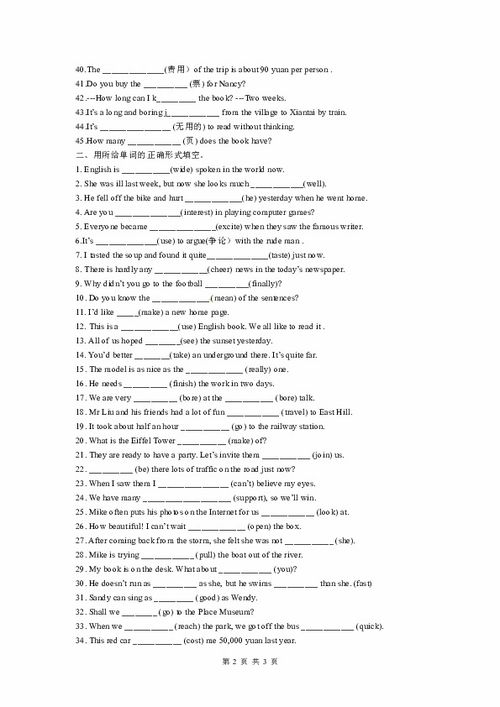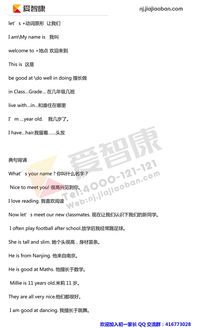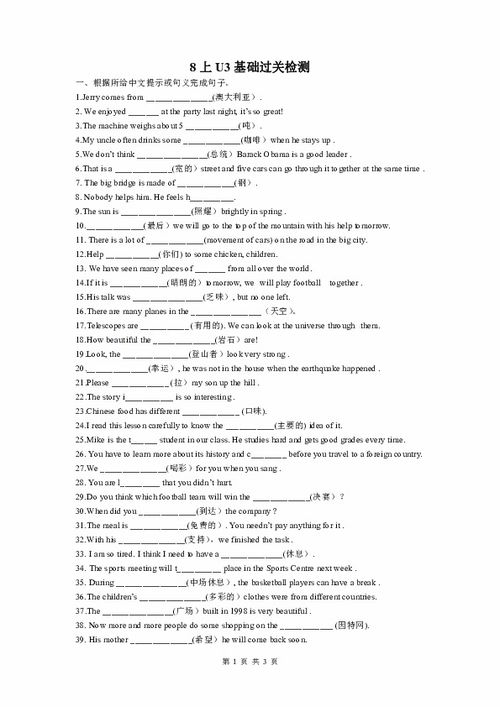译林版初一英语上册(译林出版社七年级英语上册Unit1.2重点句型,词语以及语法,拓展)
1.译林出版社七年级英语上册Unit1.2重点句型,词语以及语法,拓展
Unit1. My name's Gina. 句型:1, What's your name? My name's Jenny. / I'm Jenny. / Jenny. May I have your name? Yes, my name's Jenny. What's his/her name? His/Her name's Tony/Gina. 2, I'm Tony Brown. What's your full name? My full name/ It is Tony Brown. My first name is Tony. My last name/family name is Brown. 3, What's your/his/her telephone/phone number? It's 555-3539. 语法:1,形容词性物主代词:my(我的) your(你的) his/her/its(他/她/它的) our(我们的) your(你们的)their(他们的) 后面需要接名词,修饰名词,做前置定语。
在句中可作主语,宾语等成分。 My book is here. This is my book. 2, 主格: I you he/she/ it we you they 在句中做主语,一般放句首,后面紧跟 am/is/are 及其他动词。
I'm a student. She looks great. Unit2. Is this your pencil? 句型:1, Is this your pencil? Yes, it is. 2, Is this my pen? No, it isn't. 3, Is that his book? Yes, it is. 4, How do you spell it? = Can you spell it, please? = Spell it, please. 5, Call Alan at 495-3539. Call me/him/her/them. 给我/他/她/他们打电话. Call 4953539 拨打4953539。 Call sb. at + 电话号码 拨打……找某人 6, Is that your computer game in the lost and found case? 7, a set of keys a set of + 名词复数 语法;1,句中含be(am, is, are)一般疑问句的变法: 把be提前,如果句中有my变your,I 变you,其他的照抄不变。
肯定回答 yes, 主语+am/is/are 否定回答 No,主语+am not/aren't/isn't. 注意:回答时主语如果是物品单数或者this/that的话,用it替代主语,如果是复数人和物品用they替代。 2, be动词的用法口诀;I am, you are, is 他/她/它(he/she/it),单数is 复数are. Be动词跟随主语的变化而变化。
Unit3. This is my sister. 句型:1,Is this your sister? No, it isn't. Is she your sister? No, she isn't. 2,This is my friend. These are my friends. That is my brother. Those are my brothers. 3, Thanks for the photo of your family. Here is my family photo. photo of your family = your family photo 语法:可数名词单数变复数:一般情况下加s, book-books, 以s, x, sh, ch结尾的加es watch-watches 以辅音字母加y结尾的,把y改为i再加es boy- boys, family-families 以o结尾的有生命的加es, 无生命的加s, tomato-tomatoes, photo-photos unit4. Where's my backpack? 句型:Where's the baseball? It's in the backpack. Where's my computer game? It's under the bed. Where are his keys? They're on the dresser. Where are your books? They're on the chair. Where are her keys? They're on the table. Where are you? I'm at school. Is it on the dresser? No, it isn't. Please take these things to your sister. Can you bring some things to school? The book is on the floor. 语法: 1,询问人或物品在哪里,我们用Where, 结构为 where+is/are+人/物品名称? “……在哪里” 回答用 主语+is/are +in/at/under/on/near +地点 注意:表示“在……地方”地点前要用定冠词the 或者形容词性物主代词my/your/his/their修饰,但是两者不能同时出现,我们可以说in the room, in my room 但是绝对不可以in the my room. 词语用法:1, take v.带走, 把人或物品带到别的地方去,take … to… 把……带到……去 bring v.带来,把人或物品从别的地方带到说话的地方来 bring…to… 把……带到……来 2,please 后接动词用原形。 unit5. Do you have a soccer ball? 句型: Do you have a TV? Yes, I do/No, I don't. Do they have a computer? Yes, they do./No, they don't. Does he have a tennis racket? Yes, he does./No, he doesn't. Does she have a soccer ball? Yes, she does./No, she doesn't. Does he have a ping-pang ball? Yes, he does./No, he doesn't. Let's play soccer. Let me help you. I don't have a soccer ball. That sounds good. 语法:1,句中不含be(am,is,are)动词的 一般疑问句的变法。
也就是说句中谓语动词是实义动词时,要变为一般疑问句,在句首加do/does(当主语是第三人称单数的时候用does),第一人称变第二人称,动词变原形其他的语序不变。I have a computer. – Do you have a computer? She likes playing ping-pang.- Does she like playing ping-pang.肯定回答用yes, 主语+do/does.否定回答用No,主语+don't/doesn't. 2一般句子中当主语是第三人称单数的时候,谓语动词要起变化。
具体的变化为:一般情况加s, know-knows, 以s,x,ch,sh,o结尾的加es, teach-teaches, go-goes, 以辅音字母加y结尾,把y改为i, 再加es study-studies 3,do/does 叫做助动词(语法需要加上去翻译部出来的动词)时,后面接动词原形, Does he like reading? She doesn't like reading. She doesn't do her homework. 但是如果做实义动词(能翻译出来意思的动词)呢,遇到主语第三人称单数就要起变化。 She does her homework. 4,have的第三人称单数为 has. 5, let sb do sth 让某人做某事 (sb代表人,如果是代词用宾格,do代表动词原形) 6,play+球类 表示“踢,打,玩。
” play 。

2.苏教版初一英语上册1~5单元的知识点
1、Do you want to go to the Beijing Zoo on a class trip?
Yes,I'd like to.
2、They each have an English book in their hands.
Each of them has an English book in their hands.
3、Thank you for telling me the good news.
4、His mother tells him not to play too much computer games.
5、Don't worry about your mum,she is better now.
6、Do you know that Mr.Wu is going to teach them English?
7、He has no time searching information on the Internet because he is always busy.
8、It's harmful for eyes to read in the sun.
9、Be quiet!He is busy doing his homework.
10、It's difficult to find the answer to the question in such a short time.

3.牛津英语苏教版初一上下语法讲解
看我的 同学! 1. 冯利松 QQ 1.dream homes 梦想的家
2. live in a palace / next to a restaurant 住在宫殿里/餐馆隔壁
3. learn about the homes in different countries 了解不同国家的家
4. countries and capitals 国家和首都
5. the capital of … ……的首都
6.homes around the world 世界各地的家
7. the home pages of four foreign students 四个外国学生的主页
8. sit on the big floor cushions 坐在大垫子上
9. live with my family in a wooden house 和我的家人住在一座木屋里
10. climb a ladder to get into my house 爬梯子到房子里去
11. it rains a lot 下很多雨
12. make dinner 做饭
13. in the center of Moscow 在莫斯科中心
14. in a flat on a busy street 在繁华大街的一座公寓里
15. share…with…. 和……分享……
16. write down the meanings of some of the words 写下一些单词的意思
17. make some mistakes 犯一些错误
18.write the correct words above each mistake 把正确的单词写在每一个错误
之上
19.lie on his bunk beds 躺在他的双层床上
20. above the top bunk bed 在上层床的上面
21. have a free day 空闲一天
22. be tired after the long plane trip 在长途飞行后很累
23. where else we are going? 我们还要去哪里?
4.七年级英语上册知识点总结
初一英语上学期期中复习 【学习目标】 一、语音知识 ※1. ※2. 单词重读 'dinner 'kitchen 'shower 'people for'get pi'ano de'licious re'view 二、词汇 ※ 1. 1-6单元黑体字单词 ※ 2. 词组 what about=how about …怎么样(认为如何) fall asleep=be asleep 入睡 eat up 吃光 go to bed 上床睡觉 watch TV 看电视 only child 独生子、独生女 wash the dishes 洗盘子 at school/home/work 在学校 / 家 / 工作 go up 起床 live with sb. 和某人住在一起 三、日常用语 §1. What's your name? My name is Mike. §2. Are you happy? Yes, I am./No, I'm not. §3. What's your favorite subject? My favorite subject is English. §4. Do you like sports? Yes, I do./No, I don't. 四、语法 §1. 词类:名词、冠词、形容词、副词 §2. 比较等级 【知识讲解】 ※1. 名词 ①表示人或事物的名称,如 boy, clock, book, tree。
总的说来,名词分为专有名词和普通名词两大类。 专有名词是个别的人、事物、地点等专有的名称,如: Jim, China 专有名词的第一个字母要大写,如:Beijing, New York ②名词按其所表示的事物的性质分为可数名词和不可数名词。
可数名词:可以用数目计算,有单数和复数两种形式,如:an apple, two apples, a car, some cars 不可数名词:一般无法用数目计算,没有复数形式,且不用不定冠词a/an修饰,如:water, milk, meat, tea, bread, rice ③单数名词变复数名词的规则如下表: 注:①少数名词的复数是不规则的,如: man→men woman→women child→children ②表示民族的名词,有的在词尾加 s ,如: an American→three Americans ③有的单、复数形式相同,如: a Chinese→four Chinese a sheep→three sheep a deer→five deer ※2. 冠词 冠词是一种虚词,不能单独使用,只能和一个名词一起使用,并帮助说明此名词。冠词有两类,即定冠词the 和不定冠词a/an。
①不定冠词 常表示“一”的概念,有两种形式:a和an。a用在辅音音素开头的单数可数名词前,如:a book, a pen;an用在元音音素开头的名词前,如:an apple,an orange,an egg。
②定冠词the 常表示“这个”“那个”“这些”“那些”的概念,the在元音音素前读,在辅音音素前读 ,如:the moon, the evening。 eg. ①-Do you have an English book? -Yes, but the English book is broken. ② There is a chicken in the picture. ③ We can't see the sun at night. ④ The Browns are going to the park this Sunday. ⑤ Shanghai is in the east of China. ※3. 形容词 用来修饰名词,表示人或事物的特征,在句中可以作定语、表语、宾语补足语。
如: It's a sunny day today. Let's go to the park. This book is good. It's very nice of you to help us. 常见形容词的同义词与近义词: large→big 大的 glad→happy/pleased 高兴的 clever→bright 聪明的 ill→sick 病的 fine→well 好的 常见形容词的反义词和对应词: bad(坏的)→good(好的) big(大的)→small(小的) busy(忙的)→ free(空闲的) dry(干的)→wet(湿的) same(相同的)→different(不同的) empty(空的)→full(满的) cold(寒冷的)→hot(热的) open(开着的)→closed(关闭的) poor(穷的)→rich(富的) ※4. 副词 用来修饰动词、形容词、其他副词或全句,在句中作状语或表语。 eg. Now he is back in New York again. 现在他又回到了纽约。
Mike is a good student. He often does his homework carefully. 副词一般分为七大类: ①时间副词: now, often, then, early, ago, before ②地点副词: here, there, out, above, up, down ③方式副词: hard, well, badly, fast, slowly ④程度副词: very, much, still, almost, too, so ⑤疑问副词: how, when, why, where ⑥关系副词: when, where, why ⑦连接副词: now, where, why often 等表示“频率”的时间副词,总被放在句子中间,又称“中置副词”。这类副词有 always(总是)、usually(通常)、sometimes(有时)、ever(曾经)、never(从不)等。
“中置”规律: ①放在单个的 be 动词之后; ②放在单个实义动词之前; ③谓语动词为多个词时,放在第一个助动词或情态动词之后。 如: You are always late for school. 你总是上学迟到。
I usually go to school by bike. I never see that book. He often helps other students. He goes to work on foot sometimes. ※5. 比较等级 在进行比较的时候,形容词和副词有原级、比较级和最高级三种形式。 规则形容词和副词的比较级和最高级加 -er或-est。
(1)不规则变化的形容词和副词如下: →better→best →wors →worst (许多)many/much→more→most (几乎没有)little→less→least (远的)far→farther→farthest (老的,旧的)old (2)三种句型 ① 原级句型: as+形容词/副词+as,表示“和…一样”;否定句式:not as/so +形容词/副词+as,表示“和…不一样”。 eg. I think Kate does just as well as Ann. If you like the chicken, you may have as much as you can. I don't like the film. It's not so interesting as that one. ② 比较级句型: a. 主语+谓语+比较级+than+其它,表示“较…一些”。
eg. This city is more 。
5.初一上册英语复习资料
6. Where's Shenzhen? It's near Hong Kong. 7. Let me see.(口语)让我想想看。
see 在这是"明白、懂了",不可译作"看见"。例如: 8. Please have a seat. seat表示"座位",是个名词。
have a seat表示"就坐",也可以说take a seat, 和sit down的意思相同。 三. 语法 1. 名词所有格 名词如要表示与后面名词的所有关系,通常用名词所有格的形式,意为"……的"。
一般有以下几种形式: (1). 一般情况下在词尾加"'s"。例如: Kate's father Kate的爸爸 my mother's friend 我妈妈的朋友 (2). 如果复数名词以s结尾,只加"'"。
例如: Teachers' Day 教师节 The boys' game 男孩们的游戏 (3). 如果复数名词不以s结尾,仍加"'s"。例如: Children's Day 儿童节 Women's Day 妇女节 (4). 表示两个或几个共有时,所有格应加在后一个名词上。
例如: Lucy and Lily's room Lucy 和Lily的房间 Kate and Jim's father Kate 和Jim的爸爸 动物和无生命事物的名词的所有格一般不在词尾加"'s",而常常用介词of的短语来表示。 a map of China 一幅中国地图 the name of her cat 她的猫的名字 a picture of my family 我的家庭的一张照片 the door of the bedroom 卧室的门 2. 祈使句 祈使句主要用来表示说话人的请求、命令、建议、叮嘱等意图。
祈使句一般不用主语,读时用降调。为使语气委婉、礼貌,常在句首或句尾加please 。
在句尾时,please前多用逗号。 (1). 祈使句肯定形式的谓语动词一律用动词原形。
Go and see. 去看看。 Come in, please. 请进。
(2). 祈使句的否定形式常用don't于句首。 Don't look at your books. 不要看书。
Don't play on the road. 不要在马路上玩。 3. There be 的句子结构 There be是一个"存在"句型,表示"有"的意思, 肯定句的形式为:There be + 名词(单数或复数)+地点状语或时间状语。
be动词单复数的确定,看be后边第一个名词,当所接主语为单数或不可数名词时,be动词形式为is;当所接主语为复数名词时,be动词为are;当be动词后接两个以上主语时,be动词与最临近主语保持数上的一致。意思为"某地有某人或某物"。
如: There is an eraser and two pens on the desk. 桌子上有一块橡皮和两支钢笔。 There are two pens and an eraser on the desk. 桌上有两支钢笔和一块橡皮。
(1)there be的否定句,即在be的后面加上not。 否定形式为:There be + not + (any) + 名词+地点状语。
There is not any cat in the room. 房间里没猫。 There aren't any books on the desk. 桌子上没书。
(2)there be句型的疑问句就是将be提到句首:Be there + (any) +名词+地点状语?肯定回答:Yes, there is / are. 否定回答:No, there isn't / aren't. ---Is there a dog in the picture? 画上有一只狗吗? ---Yes, there is. 有。 ---Are there any boats in the river? 河里有船吗? ---No, there aren't. 没有。
(3)特殊疑问句:How many . . . are there (+地点状语)?"某地有多少人或物?"回答用There be . . . There's one. / There are two / three / some . . . 有时直接就用数字来回答。One. / Two . . . ---How many students are there in the classroom? 教室里有多少学生? ---There's only one. / There are nine. 只有一个。
/有九个。 (4)如果名词是不可数名词,用:How much + 不可数名词 + is there + 地点状语? How much water is there in the cup? 杯中有多少水? How much food is there in the bowl? 碗里有多少食物?。

相关推荐
声明:本网站尊重并保护知识产权,根据《信息网络传播权保护条例》,如果我们转载的作品侵犯了您的权利,请在一个月内通知我们,我们会及时删除。
蜀ICP备2020033479号-4 Copyright © 2016 学习鸟. 页面生成时间:3.971秒









